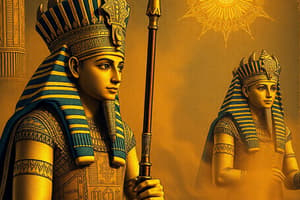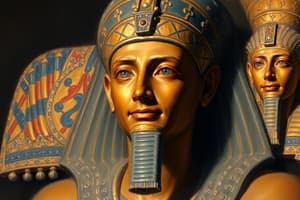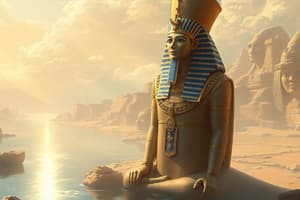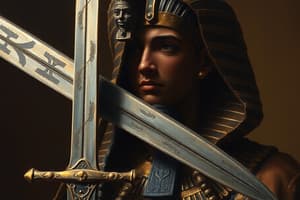Podcast
Questions and Answers
What was the conclusion about the Battle of Kadesh?
What was the conclusion about the Battle of Kadesh?
- It resulted in the annexation of new territories.
- It was a decisive victory for Ramses II.
- It was more of a stalemate than a decisive victory. (correct)
- It led to prolonged warfare in the region.
The Ancient Egyptians believed that the heart represented the intellect and emotions of a person.
The Ancient Egyptians believed that the heart represented the intellect and emotions of a person.
True (A)
What symbols are used to represent the good or bad aspects of a person's life in the judgment scene?
What symbols are used to represent the good or bad aspects of a person's life in the judgment scene?
The heart and the feather.
The devourer, which the Ancient Egyptians feared, is a creature that is part ______, part lion, and part hippopotamus.
The devourer, which the Ancient Egyptians feared, is a creature that is part ______, part lion, and part hippopotamus.
Match the following Egyptian deities with their roles in the afterlife judgment:
Match the following Egyptian deities with their roles in the afterlife judgment:
What was the outcome of the Battle of Kadesh?
What was the outcome of the Battle of Kadesh?
Ramses II is known for his extensive building projects and military campaigns.
Ramses II is known for his extensive building projects and military campaigns.
What was one of the significant achievements of Ramses II during his reign?
What was one of the significant achievements of Ramses II during his reign?
Ramses II ruled Egypt during the __________ Dynasty.
Ramses II ruled Egypt during the __________ Dynasty.
Which of the following is NOT one of Ramses II's notable building projects?
Which of the following is NOT one of Ramses II's notable building projects?
Match Ramses II's building projects with their descriptions:
Match Ramses II's building projects with their descriptions:
The Battle of Kadesh was fought against the Egyptians.
The Battle of Kadesh was fought against the Egyptians.
Who misled the forces during the Battle of Kadesh?
Who misled the forces during the Battle of Kadesh?
What is significant about Tutankhamun's tomb?
What is significant about Tutankhamun's tomb?
The Valley of the Kings was a burial site exclusively for queens.
The Valley of the Kings was a burial site exclusively for queens.
Who was the first pharaoh of the 18th dynasty?
Who was the first pharaoh of the 18th dynasty?
Ramses II is known for his involvement in the _____ of Kadesh.
Ramses II is known for his involvement in the _____ of Kadesh.
What was one of Ramses II's strategies to gain fame?
What was one of Ramses II's strategies to gain fame?
What religion did Akhenaten promote?
What religion did Akhenaten promote?
The Valley of the Kings is located near _____ city.
The Valley of the Kings is located near _____ city.
What was a main goal of Ramses II's military campaigns?
What was a main goal of Ramses II's military campaigns?
Flashcards are hidden until you start studying
Study Notes
Ramses II
- Ramses II, also known as Ramesses the Great, was a powerful pharaoh of ancient Egypt.
- He ruled during the 19th Dynasty from 1279 to 1213 BCE.
- Ramses II led numerous military campaigns to defend Egypt's borders and expand its territory.
- He is known for his battles against the Hittites.
- The Battle of Kadesh, fought around 1274 BCE, is considered one of the most famous battles of the ancient world.
- The battle led to a peace treaty between Egypt and the Hittites, marking the first peace treaty in recorded history.
- Ramses II was a prolific builder, leaving behind a legacy of magnificent temples and monuments.
- Some of his famous building projects include Abu Simbel, Ramesseum, and Karnak Temple Complex.
- Ramses II's reign is considered the pinnacle of Egyptian power and cultural achievement.
Early Pyramids
- The earliest pyramids were step pyramids, such as the Step Pyramid of Djoser.
- These pyramids had a series of steps leading up to the top, symbolizing the ascent to the heavens.
- Later, Egyptians developed the smooth-sided pyramids, which were more efficient and aesthetically pleasing.
- Some pyramids, like the Bent Pyramid at Dahshur, experiment with different angles and designs.
- The pyramids were not just tombs but symbols of a pharaoh's power and immortality.
- The pyramids' precise alignment with the stars and intricate hieroglyphs and paintings reveal the deep religious and spiritual beliefs of ancient Egyptians.
- Constructing the pyramids required a massive workforce and advanced engineering techniques.
Important Pharaohs
- The Old Kingdom had important pharaohs that built pyramids: Djoser, Sneferu, Khufu, Khafre, and Menkaure.
- The New Kingdom brought wealth to Egypt with many important rulers, including:
- Ahmose, who defeated the Hykos invaders and was the first pharaoh of the 18th Dynasty.
- Hatshepsut
- Akhenaten, who created a religion worshipping one God named Aton.
- Tutankhamun, Akhenaten's successor, reversed these changes and became king at age nine. His tomb was the only one found fully intact.
- Ramses II wanted to be the most well-known pharaoh, so he led military campaigns and built many structures, including his own city.
Valley of the Kings
- The Valley of the Kings was the burial place for pharaohs.
The Book of the Dead
- The Book of the Dead is an ancient Egyptian text that outlines the journey of the soul in the afterlife.
- The text is often found in the tombs of deceased individuals.
- It includes spells and rituals that were believed to help the deceased in their journey to the afterlife.
Studying That Suits You
Use AI to generate personalized quizzes and flashcards to suit your learning preferences.





